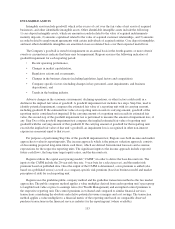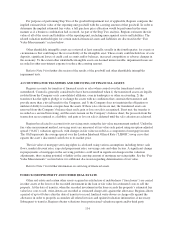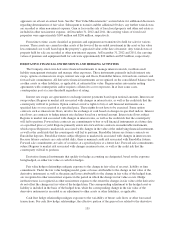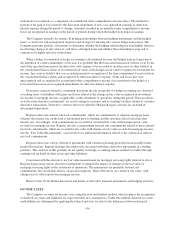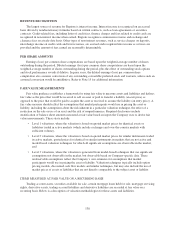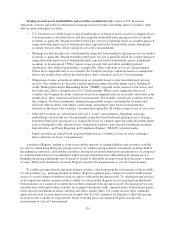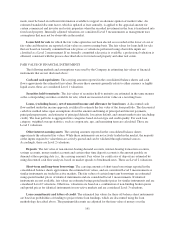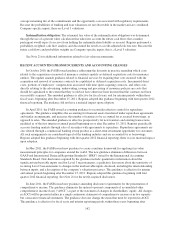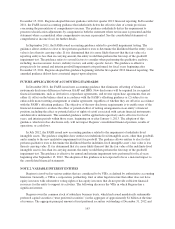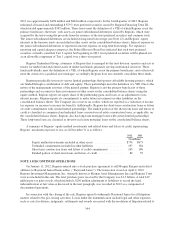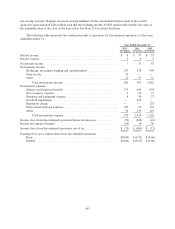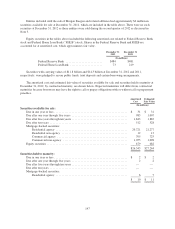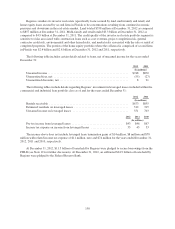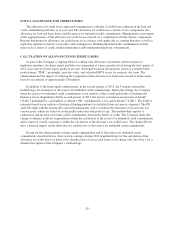Regions Bank 2012 Annual Report Download - page 158
Download and view the complete annual report
Please find page 158 of the 2012 Regions Bank annual report below. You can navigate through the pages in the report by either clicking on the pages listed below, or by using the keyword search tool below to find specific information within the annual report.average remaining life of the commitments and the opportunity cost associated with regulatory requirements.
Because the probabilities of funding and loan valuations are not observable in the market and are considered
Company specific inputs, these are Level 3 valuations.
Indemnification obligation: The estimated fair value of the indemnification obligation was determined
through the use of a present value calculation that takes into account the future cash flows that a market
participant would expect to receive from holding the indemnification liability as an asset. Regions performed a
probability-weighted cash flow analysis and discounted the result at a credit-adjusted risk free rate. Because the
future cash flows and probability weights are Company-specific inputs, this is a Level 3 valuation.
See Note 21 for additional information related to fair value measurements.
RECENT ACCOUNTING PRONOUNCEMENTS AND ACCOUNTING CHANGES
In October 2010, the FASB issued guidance addressing the diversity in practice regarding which costs
related to the acquisition or renewal of insurance contracts qualify as deferred acquisition costs for insurance
entities. This update amends guidance related to financial services by requiring that costs incurred with the
acquisition and renewal of insurance contracts be capitalized as deferred acquisition costs. Incremental direct
costs, portions of employees’ compensation associated with time spent acquiring contracts, and other costs
directly relating to the advertising, underwriting, issuing and processing of insurance policies are costs that
should be capitalized to the extent that they would not have otherwise been incurred had the contracts not been
successfully acquired. The amended guidance is effective for fiscal years, and for interim periods within those
fiscal years, beginning after December 15, 2011. Regions adopted this guidance beginning with first quarter 2012
financial reporting. The guidance did not have a material impact upon adoption.
In April 2011, the FASB issued accounting guidance to reconsider effective control for repurchase
agreements. The guidance simplifies the accounting for financial assets transferred under repurchase agreements
and similar arrangements, and increases the number of transfers to be accounted for as secured borrowings, as
opposed to sales. The amended guidance is effective prospectively for new transfers and existing transactions
modified as of the first interim or annual period beginning on or after December 15, 2011. Regions periodically
accesses funding markets through sales of securities with agreements to repurchase. Repurchase agreements are
also offered through a commercial banking sweep product as a short-term investment opportunity for customers.
All such arrangements are considered typical of the banking industry and are accounted for as borrowings.
Regions adopted this guidance beginning with first quarter 2012 financial reporting; there was no material impact
upon adoption.
In May 2011, the FASB issued new guidance to create a uniform framework for applying fair value
measurement principles for companies around the world. The new guidance eliminates differences between
GAAP and International Financial Reporting Standards (“IFRS”) issued by the International Accounting
Standards Board. New disclosures required by the guidance include: quantitative information about the
significant unobservable inputs used for Level 3 measurements; a qualitative discussion about the sensitivity of
recurring Level 3 measurements to changes in the unobservable inputs disclosed, including the interrelationship
between inputs; and a description of the company’s valuation processes. This guidance is effective for interim
and annual periods beginning after December 15, 2011. Regions adopted this guidance beginning with first
quarter 2012 financial reporting. See Note 21 for the newly-required disclosures.
In June 2011, the FASB issued new guidance amending disclosure requirements for the presentation of
comprehensive income. The guidance eliminates the option to present components of accumulated other
comprehensive income (loss) (“AOCI”) as part of the statement of changes in shareholders’ equity. All changes
in AOCI will be presented either in a single continuous statement of comprehensive income or in two separate
but consecutive financial statements. The guidance does not change the items that must be reported in AOCI.
This guidance is effective for fiscal years and interim reporting periods within those years beginning after
142



